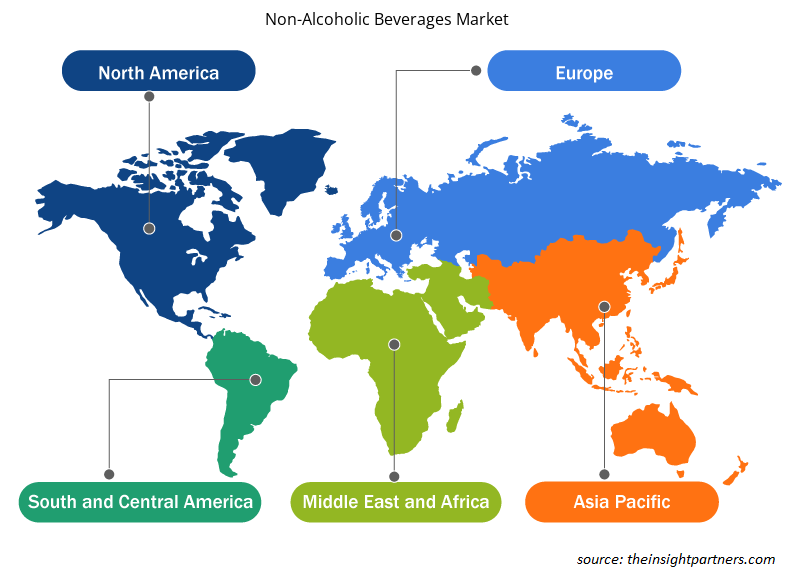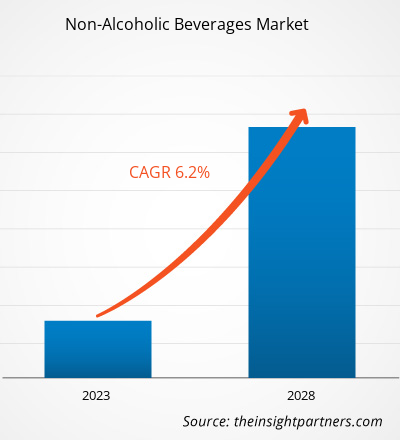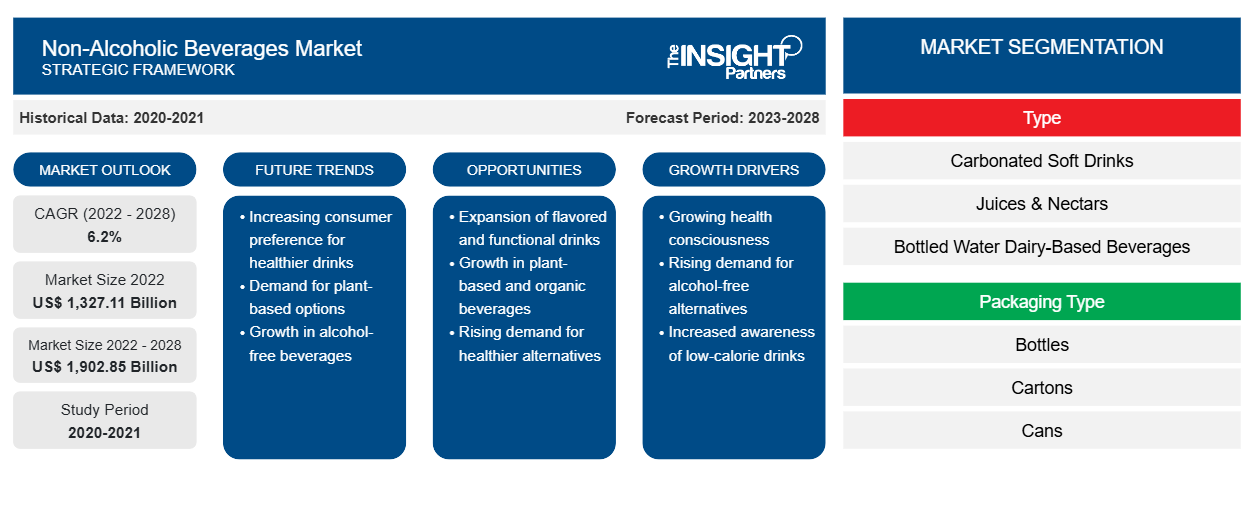من المتوقع أن ينمو حجم سوق المشروبات غير الكحولية من 1،327.11 مليار دولار أمريكي في عام 2022 إلى 1،902.85 مليار دولار أمريكي بحلول عام 2028. ومن المتوقع أن ينمو بمعدل نمو سنوي مركب قدره 6.2٪ من عام 2022 إلى عام 2028.
المشروبات الغازية والمياه المعبأة والعصائر والنكتار والمشروبات القائمة على الألبان وبدائل الألبان والشاي والقهوة الجاهزة للشرب ومشروبات الطاقة هي الأنواع المختلفة من المشروبات غير الكحولية المتوفرة في السوق. تكتسب فئة المشروبات الخالية من السكر زخمًا كبيرًا بين المستهلكين بسبب ارتفاع المخاوف الصحية وانتشار السمنة والسكري وأمراض القلب في مختلف البلدان في جميع أنحاء العالم. تشهد المشروبات الوظيفية والمشروبات المدعمة طلبًا مرتفعًا بسبب التركيز المتزايد على الصحة والتغذية. يتم استهلاك مشروبات الشعير غير الكحولية والمخاليط الجاهزة على نطاق واسع في دول الشرق الأوسط مثل المملكة العربية السعودية وإيران والإمارات العربية المتحدة بسبب اللوائح الصارمة المفروضة على استهلاك المشروبات الكحولية وحصول مشروبات الشعير على شهادات الحلال. هذا العامل يغذي نمو قطاع مشروبات الشعير غير الكحولية في سوق المشروبات غير الكحولية العالمية
في عام 2021، استحوذت منطقة آسيا والمحيط الهادئ على أكبر حصة من الإيرادات في سوق المشروبات غير الكحولية العالمية. العوامل الرئيسية التي تدفع السوق في منطقة آسيا والمحيط الهادئ هي زيادة الوعي الصحي بين المستهلكين، والطلب المرتفع على مشروبات الألبان البديلة، والشعبية المتزايدة لعصائر الفاكهة الطبيعية والعضوية. في دول مثل اليابان وكوريا الجنوبية، يعاني غالبية السكان من عدم تحمل اللاكتوز. هذا العامل يعزز شعبية مشروبات الألبان البديلة في البلدان. علاوة على ذلك، فإن سوق المشروبات غير الكحولية في منطقة آسيا والمحيط الهادئ مربح بسبب وجود قاعدة مستهلكين محتملة، والطلب القوي على المشروبات الصحية، ومشهد البيع بالتجزئة الواسع. تشهد فئة NOLO (البيرة والمشروبات الروحية والكوكتيلات الخالية من الكحول/المنخفضة الكحول) طلبًا كبيرًا في منطقة آسيا والمحيط الهادئ بسبب تغيير عادات الاستهلاك وزيادة تركيز المستهلكين على الأكل والشرب الصحي. لذلك، تعمل العديد من الشركات الناشئة التي تقدم البيرة والمشروبات الروحية الخالية من الكحول أو منخفضة الكحول على توسيع نطاقها في جميع أنحاء منطقة آسيا والمحيط الهادئ. على سبيل المثال، تم إطلاق Sipfree، وهي منصة تسوق عبر الإنترنت للبيرة والمشروبات الروحية والنبيذ غير الكحولية، في هونغ كونغ في يناير 2020، وعلى الرغم من تفشي فيروس كورونا المستجد، فقد زادت مبيعات Sipfree بشكل كبير. ومن المتوقع أن تفتح مثل هذه التوسعات فرصًا مربحة في نمو سوق المشروبات غير الكحولية في منطقة آسيا والمحيط الهادئ خلال الفترة المتوقعة.
قم بتخصيص هذا التقرير ليناسب متطلباتك
ستحصل على تخصيص لأي تقرير - مجانًا - بما في ذلك أجزاء من هذا التقرير، أو تحليل على مستوى الدولة، وحزمة بيانات Excel، بالإضافة إلى الاستفادة من العروض والخصومات الرائعة للشركات الناشئة والجامعات
-
احصل على أهم اتجاهات السوق الرئيسية لهذا التقرير.ستتضمن هذه العينة المجانية تحليلاً للبيانات، بدءًا من اتجاهات السوق وحتى التقديرات والتوقعات.
تأثير جائحة كوفيد-19 على سوق المشروبات غير الكحولية
في فترة ما قبل الجائحة، كان سوق المشروبات غير الكحولية مدفوعًا بشكل أساسي بالطلب المرتفع على المشروبات الصحية والمشروبات الجاهزة. ومع ذلك، بسبب تفشي فيروس كورونا المستجد في عام 2020، واجهت العديد من الصناعات تحديات غير مسبوقة. وشهد مصنعو الأغذية والمشروبات نموًا بطيئًا في المرحلة الأولية من الجائحة بسبب إغلاق وحدات التصنيع وانقطاعات سلسلة التوريد. ومع ذلك، أدى التحول في نمط حياة المستهلك، وارتفاع تفضيل الممارسات الغذائية الصحية، وزيادة عدد السكان المهتمين بالصحة إلى تعزيز الطلب على المشروبات غير الكحولية بشكل كبير. زاد الطلب على المشروبات النباتية مثل حليب الصويا واللوز وجوز الهند بمقدار الضعف بعد الجائحة، حيث يعتقد المستهلكون أن المشروبات النباتية تقدم قيمة غذائية أكبر من المشروبات التقليدية. ووفقًا لتقرير مينتل المنشور في يونيو 2020، وافق 25٪ من المستهلكين الذين شملهم الاستطلاع في المملكة المتحدة على أن النظام الغذائي النباتي يبدو جذابًا بسبب الجائحة. وكان لهذه العوامل تأثير إيجابي على نمو سوق المشروبات غير الكحولية.
وقد برزت اتجاهات الصحة والعافية بعد تفشي فيروس كورونا المستجد. ويشارك المستهلكون في أنشطة اللياقة البدنية المختلفة مثل اليوجا والركض وركوب الدراجات للحفاظ على صحتهم. ومن المتوقع أن يوفر هذا العامل إمكانات قوية لسوق المشروبات غير الكحولية، وخاصة في مجال مشروبات الطاقة والمشروبات الرياضية ، في السنوات القادمة.
رؤى السوق
زيادة الإقبال على المشروبات الرياضية من شأنها أن تعزز سوق المشروبات غير الكحولية
تلعب التغذية دورًا مهمًا في تحسين الأداء الرياضي. يجب على الرياضيين والرياضيين اتباع التغذية الكافية لتلبية احتياجاتهم اليومية من الطاقة والمغذيات. إلى جانب الرياضيين المحترفين والرياضيين، يشارك العديد من الأشخاص في النشاط البدني اليومي للحفاظ على صحتهم العامة. زاد عدد عشاق اللياقة البدنية في السنوات الأخيرة بسبب زيادة المخاوف الصحية والعافية. تعمل المشروبات الرياضية على تجديد مستوى الإلكتروليتات والماء والطاقة المفقودة أثناء التمرين والأنشطة البدنية. تحتوي هذه المشروبات عادةً على الكربوهيدرات والبوتاسيوم والصوديوم والمغنيسيوم والكالسيوم التي تعمل على إعادة الترطيب وتجديد مخزون الجليكوجين وتأخير التعب بعد التمرين. تعد المخاوف الصحية واللياقة البدنية المتزايدة والعدد المتزايد من عشاق الرياضة العوامل الرئيسية التي تدفع مبيعات المشروبات الرياضية على مستوى العالم. وبالتالي، فإن التبني المتزايد للمشروبات الرياضية يحرك بشكل كبير سوق المشروبات غير الكحولية.
رؤى النوع
بناءً على النوع، تم تقسيم سوق المشروبات غير الكحولية العالمية إلى مشروبات غازية، ومياه معبأة، وعصائر ورحيق، ومشروبات تعتمد على منتجات الألبان، ومشروبات بديلة للألبان، وشاي وقهوة جاهز للشرب، وبيرة غير كحولية، ومشروبات الشعير، وغيرها. يتم تقسيم شريحة العصائر والرحيق إلى عصائر فواكه فوارة وغيرها. احتلت شريحة المشروبات الغازية أكبر حصة في سوق المشروبات غير الكحولية العالمية في عام 2021، ومن المتوقع أن تنمو شريحة المشروبات البديلة للألبان بأسرع معدل نمو سنوي مركب خلال فترة التوقعات. المشروبات الغازية هي مشروبات غازية غير كحولية مصنوعة من الماء النظيف والسكر والمحليات الطبيعية أو بدائل السكر (في المشروبات الغذائية) والكافيين ومكونات النكهة الاصطناعية وتركيزات عصير الفاكهة والمواد الحافظة والمواد المضافة للتلوين. تعد سبرايت وكوكا كولا وماونتن ديو ومونستر من أشهر العلامات التجارية للمشروبات الغازية في جميع أنحاء العالم. تتوفر المشروبات الغازية على نطاق واسع في متاجر التجزئة ومحلات السوبر ماركت والهايبر ماركت وآلات البيع ودور السينما ومحلات المشروبات الغازية ومتاجر البيع بالتجزئة عبر الإنترنت. إن أنماط الحياة المتغيرة للمستهلكين وارتفاع الدخل المتاح وزيادة الطلب على الأطعمة والمشروبات الغازية هي التي تدفع سوق المشروبات الغازية إلى الأمام.
رؤى الفئة
بناءً على الفئة، تم تقسيم سوق المشروبات غير الكحولية العالمية إلى مشروبات خالية من السكر ومشروبات تقليدية. احتلت المشروبات التقليدية حصة سوقية أكبر في عام 2021. إن الانتشار المتزايد للسمنة والسكري وارتفاع ضغط الدم وأمراض القلب والأوعية الدموية يدفع الطلب على المشروبات الخالية من السكر. وفقًا للاتحاد الدولي للسكري، كان حوالي 537 مليون شخص في جميع أنحاء العالم مصابين بمرض السكري في عام 2021. تعمل العديد من شركات تصنيع المشروبات بشكل استباقي على تطوير منتجات بمحليات طبيعية ومنخفضة السعرات الحرارية لتلبية الطلب المتزايد على المشروبات الخالية من السكر. هذا العامل هو الذي يحرك سوق هذا القطاع.
رؤى إقليمية حول سوق المشروبات غير الكحولية
لقد قام المحللون في Insight Partners بشرح الاتجاهات والعوامل الإقليمية المؤثرة على سوق المشروبات غير الكحولية طوال فترة التوقعات بشكل شامل. يناقش هذا القسم أيضًا قطاعات سوق المشروبات غير الكحولية والجغرافيا في جميع أنحاء أمريكا الشمالية وأوروبا ومنطقة آسيا والمحيط الهادئ والشرق الأوسط وأفريقيا وأمريكا الجنوبية والوسطى.

- احصل على البيانات الإقليمية المحددة لسوق المشروبات غير الكحولية
نطاق تقرير سوق المشروبات غير الكحولية
| سمة التقرير | تفاصيل |
|---|---|
| حجم السوق في عام 2022 | 1,327.11 مليار دولار أمريكي |
| حجم السوق بحلول عام 2028 | 1,902.85 مليار دولار أمريكي |
| معدل النمو السنوي المركب العالمي (2022 - 2028) | 6.2% |
| البيانات التاريخية | 2020-2021 |
| فترة التنبؤ | 2023-2028 |
| القطاعات المغطاة |
حسب النوع
|
| المناطق والدول المغطاة |
أمريكا الشمالية
|
| قادة السوق وملفات تعريف الشركات الرئيسية |
|
كثافة اللاعبين في سوق المشروبات غير الكحولية: فهم تأثيرها على ديناميكيات الأعمال
يشهد سوق المشروبات غير الكحولية نموًا سريعًا، مدفوعًا بالطلب المتزايد من جانب المستخدم النهائي بسبب عوامل مثل تفضيلات المستهلكين المتطورة والتقدم التكنولوجي والوعي المتزايد بفوائد المنتج. ومع ارتفاع الطلب، تعمل الشركات على توسيع عروضها والابتكار لتلبية احتياجات المستهلكين والاستفادة من الاتجاهات الناشئة، مما يؤدي إلى زيادة نمو السوق.
تشير كثافة اللاعبين في السوق إلى توزيع الشركات أو المؤسسات العاملة في سوق أو صناعة معينة. وهي تشير إلى عدد المنافسين (اللاعبين في السوق) الموجودين في مساحة سوق معينة نسبة إلى حجمها أو قيمتها السوقية الإجمالية.
الشركات الرئيسية العاملة في سوق المشروبات غير الكحولية هي:
- شركة كوكا كولا
- شركة بيبسيكو
- نستله
- ريد بول
- شركة سنتوري القابضة المحدودة
إخلاء المسؤولية : الشركات المذكورة أعلاه ليست مرتبة بأي ترتيب معين.

- احصل على نظرة عامة على أهم اللاعبين الرئيسيين في سوق المشروبات غير الكحولية
تشمل الجهات الفاعلة الرئيسية العاملة في سوق المشروبات غير الكحولية العالمية شركة Coca Cola Company وPepsiCo وNestle وRed Bull وSuntory Holdings Limited وDanone SA وCalifia Farms LLC وKeurig Dr Pepper Inc وAsahi Group Holdings Limited وBolthouse Farms Inc وHeineken NV وCoolberg Beverages Pvt Ltd وGoya Foods Inc وAnheuser-Busch InBev NV وCarlsberg AS. تركز الجهات الفاعلة العاملة في سوق المشروبات غير الكحولية العالمية على توفير منتجات عضوية وخالية من الكائنات المعدلة وراثيًا ونباتية وخالية من الغلوتين بنكهات جديدة لتلبية متطلبات المستهلك المتغيرة. على سبيل المثال، في عام 2019، أطلقت شركة Coca-Cola Europacific Partners عصائر فوارة إلى مجموعة Honest Organic Lemonade. يتم تصنيع المنتج من عصير الفاكهة العضوي والسكر، في حين أنه لا يحتوي على محليات أو نكهات صناعية. ومن المتوقع أن تكتسب مثل هذه المنتجات المبتكرة جاذبية هائلة لدى المستهلكين، مما يدفع نمو سوق المشروبات غير الكحولية.
تقرير يسلط الضوء على
- اتجاهات الصناعة التقدمية في سوق المشروبات غير الكحولية لمساعدة اللاعبين على تطوير استراتيجيات فعالة طويلة الأجل
- استراتيجيات نمو الأعمال التي تتبناها الأسواق المتقدمة والنامية
- التحليل الكمي لسوق المشروبات غير الكحولية من 2020 إلى 2028
- تقدير الطلب العالمي على المشروبات غير الكحولية
- تحليل القوى الخمس لبورتر لتوضيح فعالية المشترين والموردين العاملين في الصناعة
- التطورات الأخيرة لفهم سيناريو السوق التنافسي
- اتجاهات السوق وتوقعاته، فضلاً عن العوامل التي تدفع وتكبح نمو سوق المشروبات غير الكحولية
- المساعدة في عملية اتخاذ القرار من خلال تسليط الضوء على استراتيجيات السوق التي تدعم المصلحة التجارية، مما يؤدي إلى نمو السوق
- حجم سوق المشروبات غير الكحولية في مختلف العقد
- نظرة عامة مفصلة وتقسيم السوق، بالإضافة إلى ديناميكيات صناعة المشروبات غير الكحولية
- حجم سوق المشروبات غير الكحولية في مختلف المناطق مع فرص نمو واعدة
- التحليل التاريخي (سنتان)، سنة الأساس، التوقعات (7 سنوات) مع معدل النمو السنوي المركب
- تحليل PEST و SWOT
- حجم السوق والقيمة / الحجم - عالمي، إقليمي، بلد
- الصناعة والمنافسة
- مجموعة بيانات إكسل
التقارير الحديثة
تقارير ذات صلة
شهادات العملاء
سبب الشراء
- اتخاذ قرارات مدروسة
- فهم ديناميكيات السوق
- تحليل المنافسة
- رؤى العملاء
- توقعات السوق
- تخفيف المخاطر
- التخطيط الاستراتيجي
- مبررات الاستثمار
- تحديد الأسواق الناشئة
- تحسين استراتيجيات التسويق
- تعزيز الكفاءة التشغيلية
- مواكبة التوجهات التنظيمية























 احصل على عينة مجانية ل - سوق المشروبات غير الكحولية
احصل على عينة مجانية ل - سوق المشروبات غير الكحولية